
5 April 2005
The Glacier Express - Continuous Operational and Technological Development
In its 75-year-old history the travel and experience product Glacier Express has undergone constant development. And the drive for innovation is continuing.
A Continuous Rail Network is Created
The metre gauge network between Zermatt and St. Moritz as it exists today was not part of the original plan. The construction of the railway lines started at either end of today's Glacier Express route and grew from there. The originally independent line sections were only joined up in the course of time. Luckily the Federal Licence Office in Bern at the time ordered the Visp Zermatt Bahn (VZ) to amend its plans and have a one metre instead of a 75 centimetre gauge track. Was it foresight or simply luck that the VZ adopted the same basic rolling stock standards (brakes, coupling, profile etc.) the RhB had used for its first line section (Landquart-Klosters) which was opened in 1889?
The western-most line section of today's Glacier Express, the stretch from Visp to Zermatt, was operated by the Visp-Zermatt Bahn from 18 Jul 1891. On the 35-kilometre long line six Abt system rack sections measuring 7.7 km in total helped locomotives overcome the steep gradients. Maximum gradients on the adhesion sections are 25 o/oo (or 1 in 40) and 125 o/oo (or 1 in 8) on the cogwheel sections. The trains only operated during the summer months and were hauled by steam locomotives (HG 2/3).
Independently of this railway the construction of the first sections of the Rhätische Bahn got underway in the Canton of Grisons, at the other end of today's line. On 10 Jul 1904 the first train made the journey from Chur to St. Moritz (Albula line). Once the Chur-Thusis-Samedan-St.Moritz Albula line was opened and with the Reichenau-Ilanz line section already being fully operational, a large part of what was later to become the Glacier Express line was already up-and-running in the Grisons. The train line between Ilanz and Disentis was completed on 1 Aug 1912. This was the final line section of the RhB network which was later to be used by the Glacier Express. There were no cogwheel sections on the lines of the Rhätische Bahn. The trains were pulled by steam locomotives.
Once the above-mentioned railway lines had been completed the railway pioneers started to consider the possibility of establishing a rail link from the Matterhorn village to the Engadine. Admittedly there was still a 100-km gap between the two final destinations of Visp and Disentis. Initial projects for a one metre gauge railway from Brig, or Visp, to Gletsch and from there via Furka-Andermatt-Oberalp to Disentis date from 1904, but the railway was not to become reality for many years to come.
 Once the Brig-Furka-Disentis Bahn (BFD) company was founded in 1910, construction work got underway in the Goms in 1911, in Andermatt in May 1912, and in June 1912 building in Disentis started. The first line section of the Brig-Furka-Disentis Bahn (BFD) from Brig to Gletsch was opened officially on 30 Jun 1914. But when World War I broke out construction towards the Furka was delayed. The Italian work force left the construction sites within days and returned to Italy. The money supplies from predominantly French shareholders dried up as well. In 1923 the BFD was finally forced to file for bankruptcy. In 1925 stakeholders lead by the VZ and RhB companies bought the Brig-Disentis line for about CHF 1.75 million at auction and founded the Furka Oberalp Bahn (FO) as successor of the BFD. With a grant of CH 3.5 million from the government (military considerations were decisive) the as yet incomplete structures and tracks were finished. The VZ management was put in charge of the general management of the new concern. The first trial train made the journey to Disentis on 18 Oct 1925 and on 3 Jul 1926 the Gletsch-Andermatt-Disentis line was officially opened. As with the VZ, steep gradients were overcome with the help of the Abt rack system. From this date the first scheduled through trains were in operation between St. Moritz and Brig, though not yet under the name Glacier Express. Once the Brig-Furka-Disentis Bahn (BFD) company was founded in 1910, construction work got underway in the Goms in 1911, in Andermatt in May 1912, and in June 1912 building in Disentis started. The first line section of the Brig-Furka-Disentis Bahn (BFD) from Brig to Gletsch was opened officially on 30 Jun 1914. But when World War I broke out construction towards the Furka was delayed. The Italian work force left the construction sites within days and returned to Italy. The money supplies from predominantly French shareholders dried up as well. In 1923 the BFD was finally forced to file for bankruptcy. In 1925 stakeholders lead by the VZ and RhB companies bought the Brig-Disentis line for about CHF 1.75 million at auction and founded the Furka Oberalp Bahn (FO) as successor of the BFD. With a grant of CH 3.5 million from the government (military considerations were decisive) the as yet incomplete structures and tracks were finished. The VZ management was put in charge of the general management of the new concern. The first trial train made the journey to Disentis on 18 Oct 1925 and on 3 Jul 1926 the Gletsch-Andermatt-Disentis line was officially opened. As with the VZ, steep gradients were overcome with the help of the Abt rack system. From this date the first scheduled through trains were in operation between St. Moritz and Brig, though not yet under the name Glacier Express.
In 1927 the decision was made to electrify the Visp-Zermatt line section with a single phase alternating current system 10.5 kV (today it is 11 kV), 16 2/3 Hertz. So now the Visp-Zermatt Bahn was operating on the same current system as the Rhätische Bahn. From the electricity point of view this opened the way for the Glacier Express through service. Originally the intention had been to power the VZ Bahn with a direct current system (the same as that used to power the Gornergrat Bahn in Zermatt, the first electric rack-railway in Switzerland) as used to be usual for rack-railways. Alternating current was a novelty for rack railways, and required special structural features. The locomotives had to be built to be especially light (light metal carbody). This compensated for the weight of the heavy transformer. Electric operation was introduced on 1 Oct 1929. The entire network of the Rhätische Bahn had already been operating with electricity since 1922.
Even when the licence application for the Brig-Visp line section was submitted in 1928 the possibility of direct connections between Furka and Zermatt, Göschenen and Zermatt, Chur and Zermatt, as well as St. Moritz and Zermatt, were being considered. The name "Glacier" popped up several times in the management board minutes of the FO. The name had been put forward by Mr. Bener, then manager of the RhB and representative of the RhB on the FO's board of directors. On 14 Jan 1930 the Nouvelliste Valaisan informed its readers that the connection between Zermatt and St. Moritz was called the Glacier Express.
 All three railway companies from the outset invested considerable amounts of money in the improvement and modernisation of rolling stock. The RhB ordered the lounge car (Abs4ü 61) with a cogwheel brake which was delivered in 1929. And the RhB built existing 2nd and 3rd class carriages (ABC 4ü 604-607). The FO modernised its passenger cars (C4ü 260); all carriages were fitted with an enclosed platform and concertina-style corridor connections. The VZ ordered 3 luxurious light carriages with one 2nd and one 1st class lounge compartment each (AB4ü 101-103). One of these carriages is still being used by the Matterhorn Gotthard Bahn and is available in the form of an open-air carriage for nostalgia train operations. Another is in service on the Dampfbahn Furka Bergstrecke. The German company MITROPA, which used to operate dining cars on various European luxury trains, ordered a metre gauge restaurant car (today's Gourmino car 3812) which initially was in service on the Chur-Disentis line. All three railway companies from the outset invested considerable amounts of money in the improvement and modernisation of rolling stock. The RhB ordered the lounge car (Abs4ü 61) with a cogwheel brake which was delivered in 1929. And the RhB built existing 2nd and 3rd class carriages (ABC 4ü 604-607). The FO modernised its passenger cars (C4ü 260); all carriages were fitted with an enclosed platform and concertina-style corridor connections. The VZ ordered 3 luxurious light carriages with one 2nd and one 1st class lounge compartment each (AB4ü 101-103). One of these carriages is still being used by the Matterhorn Gotthard Bahn and is available in the form of an open-air carriage for nostalgia train operations. Another is in service on the Dampfbahn Furka Bergstrecke. The German company MITROPA, which used to operate dining cars on various European luxury trains, ordered a metre gauge restaurant car (today's Gourmino car 3812) which initially was in service on the Chur-Disentis line.
On 5 Jun 1930, with the opening of the 9-kilometre-long one metre gauge link between Visp and Brig, the first through train was able to make the journey from Zermatt to St. Moritz.
1930: The Glacier Express is Born
Those in charge of the railways had been waiting for the completion of this section for some time, and acted accordingly. On 22 Jun 1930 the Glacier Express was put into operation between Zermatt and St. Moritz on a trial basis. At its meeting of 10 Jun 1930, the FO's board of directors decided that the Glacier Express would officially enter into service on 25, 26, and 27 Jun 1930. The first official Glacier Express, requiring no change of carriage, or trains, for passengers, made its journey from Zermatt to St. Moritz on Wednesday 25 Jun 1930. The first train in the reverse direction departed from St. Moritz on Thursday, 26 Jun 1930. About 70 people were invited to travel on the first run of the Glacier Express to St. Moritz. The event was celebrated at the Suvretta House in St. Moritz. The guests travelled back to Zermatt by Glacier Express on the following day. This epoch-making event was recorded in the 43rd annual report of the Rhätische Bahn as follows: "On 26 Jun 1930 the first fast train from St. Moritz to Zermatt, the auspiciously-named Glacier Express, made its first official through journey complete with dining car. It has lived up to the high expectations placed on it. And today the Glacier Express is a hit in terms of promoting Switzerland as a whole as well". In its first year the showpiece train was in operation as an express service from 1 Jul 1930 to 10 Sep 1930 and from 11 Sep 1930 to 4 Oct 1930 as a "passenger train" between St.Moritz, Chur, and Brig.
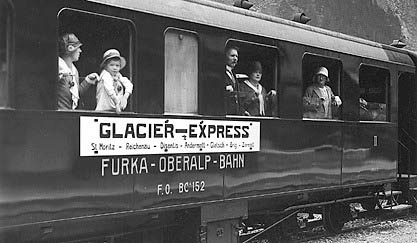
The first official Glacier Express, requiring no change of carriage, or trains,
for passengers, made its journey from Zermatt to St. Moritz on Wednesday,
25 Jun 1930.
Being composed of one passenger car each from the RhB, FO, and VZ, the Glacier Express symbolised the official connection between the three railways and three regions. The line was officially inaugurated with a special train featuring two dining cars, two 1st and 2nd class carriages of the FO (AB4), the Abs4ü61 lounge car of the RhB (which is still in service as lounge car AS 1161), and a F4ü of the RhB. Henceforth the three railways, Brig Visp Zermatt Bahn (BVZ), Furka Operalp Bahn (FO), and Rhätische Bahn (RhB), allocated their best rolling stock to the service: the RhB its ABs C 4ü 61, a 2nd/3rd class 604-607 series carriage, the VZ a 1st/2nd class carriage with lounge compartment (AB 101-103), and the FO a C4ü 260. These were joined by a new dining car ordered by MITROPA (today's Gourmino car 3812). Although there was now a continuous track between St. Moritz to Zermatt, steam locomotives continued to be in operation between Brig and Disentis since this line section was not yet electrified. Because of this the passenger carriages required extensive fittings (heating, lighting).
Early Glacier Express Locomotives
Between Zermatt and Brig the VZ deployed its famous HGe 4/4 "crocodiles" to pull the train. The maximum haulage load of the electric locomotives with up to 1,000 HP was 80 tonnes. Operating in adhesion mode they reached maximum speeds of 45 km/h and in cogwheel mode 20 km/h. Locomotives 11, 13, and 15 are still being used by the Matterhorn Gotthard Bahn for non-revenue and nostalgia train services.
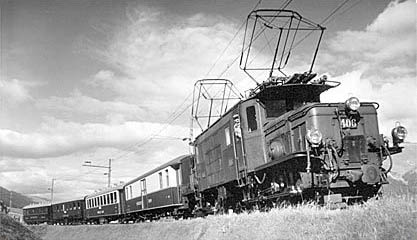
1930 train with Crocodile locomotive.
Up until 1942 the FO's Type HG 3/4 (No. 1-10) 600 HP steam locomotives built in 1913/14 with the ability to haul up to 60 tonnes on the cogwheel line sections took over in Brig and pulled the train to Disentis. These locomotives travelled at a maximum of 45 km/h on adhesion tracks and 20 km/h on rack sections. Three of these steam locomotives nowadays are being used by the Dampfbahn Furka Bergstrecke (a nostalgia railway) between Realp and Gletsch. Two of the locomotives (No. 1 and 9) were in service in Vietnam for several years. Thanks to a spectacular campaign they were brought back to Switzerland.
From Disentis to St. Moritz the Rhätische Bahn deployed the famous Ge 6/6 l electric crocodile locomotive. This 1,075 HP engine travelled at a maximum speed of 45 km/h, later 55 km/h.
The journey between Zermatt and St. Moritz lasted from 07:30 hours to 18:20 hours and the journey in the reverse direction took from 08:15 hours until 18:55 hours, which means the travel time was just under 11 hours. Between Zermatt and Brig as well as Disentis and St. Moritz the Glacier Express was powered by electricity from day one. The Brig-Disentis section of the line was not electrified until 1 Jul 1941. Like the RhB (1922), and BVZ (1929), the FO was powered by a single phase alternating current system (10.5 kV - 16 2/3 Hertz). So now all three railways of the Glacier Express operated on the same power system and the Glacier Express line was electrified throughout. The times of steam traction with relative little power became a thing of the past and more efficient electric traction took its place. The FO used its newly built electric locomotives HGe 4/4 of the 31-37 series for the Glacier Express. These were 1,200 HP locomotives with maximum speeds of 55 km/h (rack sections 30km/h). Because of the increased haulage load (80 tonnes instead of 60 tonnes), and faster speeds, and with no more stops for water and coal, the travel time on this section of the line decreased considerably.
Once electrification between Brig and Disentis was complete and the line was officially opened on 1 Jul 1942 the travel time between Brig and Disentis dropped by 40 minutes to about 4 hours. Henceforth the whole journey took about 10 hours.
Demand was great. The passenger total for the July to September operating period reached about 20,000 per year. Because of the high-altitude Alpine terrain by the Furka Pass the FO was forced to suspend the service between Oberwald and the Ursenen Valley at the start of winter. Overhead contact installations had to be dismantled and wooden masts removed on line sections which were particularly at risk. The Steffenbach Bridge was put in its winter position and the tunnel openings were shut tightly to stop snow from entering. These elaborate procedures in autumn, but particularly in spring, took up a lot of time and on each occasion cost several hundred thousand Swiss francs. Swiss passengers temporarily filled the gap left by the lack of foreign visitors after the outbreak of World War II. The showpiece train continued to operate until autumn 1942. Because of the war the Glacier Express service was suspended during the years 1943 to 1946.
Step-by-Step Further Development (1947-1982)
After the war the Glacier Express was revived in 1947. It no longer had the lounge cars but featured first class carriages of the Rhätische Bahn. And the RhB deployed carriages with 2nd class compartments as well as, as in 1930, the ABC 1604-1607 (ex 604-607) carriages. During the war the FO modernised several passenger carriages in its own workshops and these were now being used for the Glacier Express. The circuit of the dining cars was extended to cover the stretch between Disentis to Oberalpsee. In the same year the RhB received a new Ge 4/4 type locomotive. These locomotives travelled faster (75km/h) and were more powerful (1,560 HP)
By the early 1950s demand had reached such proportions that the FO, which could only haul 5 carriages at a time, had to duplicate its service. The RhB's one metre gauge carriages which had been built out of steel pre-war in Switzerland and weighed 20 to 40 tonnes were too heavy for use on the rack sections of the FO with maximum gradients of 110 o/oo (or 1 in 9.1) and therefore not really suitable to help cope with increasing passenger numbers. From 1955 the VZ used the light metal carriages with a tare weight of 11-12 tonnes and the FO ordered the manufacturer Flug und Fahrzeugwerke Altenrhein to make an aluminium carriage with self-supporting carbody. This feature made it possible for the first passenger carriage with 64 seats and a weight of just 11.7 tonnes to be constructed. The new concept proved successful and other train carriage builders followed suit. A new standard metre gauge carriage which was then built in large numbers for various railway companies came into use. In 1951 the travel time from St. Moritz to Zermatt was about 10 hours and the reverse journey took 9 hours 40 minutes.
On 3 Jun 1956 (on lines operated by the FO in 1959) third class rail travel was finally abolished across Europe and replaced by the two-class system. As far as the Glacier Express was concerned third class compartments were temporarily upgraded to second class, and second class compartments were turned into first class (usually without making any adjustments apart from changing the signs).
 Gradually the journey time was reduced to under 9 hours. In this effort the acquisition of new powerful traction engines and locomotives which could travel at speeds of up to 65 km/h by the RhB and BVZ (the VZ changed its name to Brig-Visp-Zermatt Bahn in 1962) and the shortening of the 20-minute stop in Andermatt were vital. In the fifties and sixties the railway companies invested heavily in safety and infrastructure. Gradually the journey time was reduced to under 9 hours. In this effort the acquisition of new powerful traction engines and locomotives which could travel at speeds of up to 65 km/h by the RhB and BVZ (the VZ changed its name to Brig-Visp-Zermatt Bahn in 1962) and the shortening of the 20-minute stop in Andermatt were vital. In the fifties and sixties the railway companies invested heavily in safety and infrastructure.
In the sixties all three railway companies modernised and replaced the train's rolling stock. Thanks to the introduction of new light metal and light steel carriages locomotives on the FO line section were now able to haul 6 carriages.
In 1962 through carriages from and to Pontresina were added to the express train. In 1965 these through carriages were eliminated again. The railways once again focussed their attention on the traditional original line between St. Moritz and Zermatt. Thanks to the new ABDeh 8/8 traction engines of the BVZ the travel time could be further reduced and now was 8 hours 36 minutes.
And in 1968 there was another major change. The three railway companies decided to give the Glacier Express a new, unified look, and the whole train was painted red.
From 1969 dining cars travelled as far as Andermatt. In 1970 the Swiss parliament agreed to a loan of CHF 78 million for the construction of the Furka Base Tunnel. In 1973 construction work got underway at both ends, in the Valais and in Uri, at the same time.
In 1975, in response to increasing demand on the FO line section, duplicated Glacier Express services were introduced at weekends.
Passenger numbers increased greatly while the new tunnel between Oberwald and Realp was being built. Just before the planned closure of the Gletsch-Realp line section demand rocketed. A lot of people wanted to make the journey on the Furka-Bergstrecke and catch the view of the famous Rhone Glacier one final time. Triplicated services were a key feature of the scheduled daily services of the showpiece train in 1981. On 13 Sep 1981 the FO deployed 56 relief trains in addition to the scheduled services!
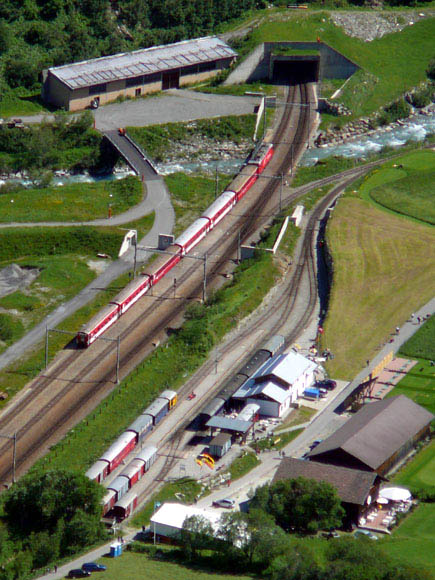
A train is about to enter the east portal of the Furka Base Tunnel at Realp.
The tracks to the right belong to the Dampfbahn Furka Bergstrecke (DFB) which
follow the original line over the mountain to Furka. Dikes contain the Reuss
River to protect the area from flooding - 23 Jun 2007 Peter Keller
After various geological problems the two Furka Base Tunnel borings finally met on 2 Apr 1981 and the builders celebrated this achievement on 30 Apr 1981. The cost of the tunnel in the end amounted to CHF 311 million. On 11 Oct 1981 the last train (a special army train transporting soldiers) made the journey from Brig along the Furka Bergstrecke to Andermatt.
The planned dismantling of the track through the mountains (Bergstrecke) was delayed because the operation of services through the Furka Base Tunnel was not absolutely guaranteed. And there were several campaigns to save the line with its unique technological and scenic features. In 1983 the Verein Furka Bergstrecke was founded and the line was saved. Once the line sections had been reopened bit by bit, a summer nostalgia steam train service started operating between Realp and Gletsch in June 2000. Most of these steam trains were hauled by former Glacier Express steam locomotives.
Year-Round Glacier Express Service
On 26 Jun 1982 the Furka Base Tunnel was officially inaugurated and the all year connection between Valais and Grisons introduced. At the time, the 15.4-kilometre-long Furka Base Tunnel was the longest metre gauge tunnel in the world and held this record until the RhB in 1999 opened the Vereina Tunnel, a tunnel which is not on the Glacier Express route. Until services through the Furka Base Tunnel were introduced the Glacier Express normally operated from the beginning of June to mid October. In 1982/83 the Glacier Express for the first time ever operated in winter as well and in its first winter season transported 17,600 passengers.
The fears that the Glacier Express would lose some of its appeal without the Furka-Bergstrecke proved unfounded. The three railway companies operating the Glacier Express, those in charge of tourism in the train's final destinations of St. Moritz and Zermatt, as well as Switzerland Tourism, felt there was great potential in the year-round rail link. At all levels great efforts were made to increase the attractiveness and build up the mystique surrounding the showpiece train. The best rolling stock was being deployed and state-of-the-art information and communication equipment put in operation, because technological features now allowed this. Passengers were unaware of the many adjustments and standardisations which had been necessary to operate the three hitherto predominantly separately run railways in an economic and modern way. Based on the existing standardisation organisation UIC (Union International des Chemins de Fer), the UICA (Union International des Chemins de Fer Alpin) for railways in the Alps was founded. Demand for the showpiece train continued to rise and over a period of three years passenger numbers doubled yearly, reaching a total of 160,000 passengers.
Glacier Express passengers from 3 Jun 1984 were offered the opportunity to reserve individual seats. This was an absolute novelty as far as rail travel within Switzerland was concerned and increased passenger convenience considerably. It meant passengers were spared the bother before departure. With no computer system in place reservations were made and confirmed by phone or postcard. For groups reservations had been obligatory for some time. The Rhätische Bahn had a light metal dining car which was in use from 1984 built for the Glacier Express.
In 1985 two additional Glacier Express trains under the same brand name were introduced in each direction. This meant that increased demand during the six summer months was met. So now three train pairs operated in each direction during the high season.
In the summer of 1985 the first feeder line from Davos, to complement the St. Moritz to Zermatt Glacier Express, was created. And at the same time the rail operators broadened the dining car and mini bar service. With the exception of one train (Zermatt-Chur) all express trains featured a dining car which was transferred to the train travelling in the opposite direction in Andermatt or Brig respectively.
Glacier Express Driven by Innovation
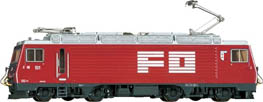 From 1986 the FO, and from 1990 the BVZ, first used the new HGe 4/4 II multipurpose locomotives as "showpiece engines" on their line sections. They are still operating today. The powerful high performance 2,500 HP locomotives increased the haulage load to today's 135 tonnes. Cutting-edge engineering including thyristor traction technology, differential drive systems, and new brake technology, made it possible to achieve maximum speeds of 90 km/h. Speeds on ascending and descending mountain track operating in cogwheel-mode were increased as well. From 1986 the FO, and from 1990 the BVZ, first used the new HGe 4/4 II multipurpose locomotives as "showpiece engines" on their line sections. They are still operating today. The powerful high performance 2,500 HP locomotives increased the haulage load to today's 135 tonnes. Cutting-edge engineering including thyristor traction technology, differential drive systems, and new brake technology, made it possible to achieve maximum speeds of 90 km/h. Speeds on ascending and descending mountain track operating in cogwheel-mode were increased as well.
With the aim of offering Glacier Express passengers a top travel experience the FO in 1987 introduced a panorama car on a trial basis. Since it was just a trial at the time the panorama car was made by placing a new, light steel carbody on top of an older, but well-preserved, underframe of a former passenger car. This new carriage was very popular among passengers. In the following years three more, virtually identical, panorama cars were constructed. Due to the positive response the BVZ and FO ordered 14 new panorama cars, type AS 2011-2014 in the case of the BVZ, and 4011-4020 for the FO, from the Italian constructor Breda halfway through 1990. An important detail was that the maker worked with the famous Italian designer Pininfarina. Pininfarina was responsible for the distinctive interior and exterior look of the carriages. Since the introduction of the new timetable on 23 May 1993 the new panorama cars have been predominantly integrated in the Glacier Express trains and characterising its appearance.
In 1993 the 903/905 panorama train pair inaugurated a new era. Each of these two trains features five air-conditioned first class passenger cars of the FO or BVZ and between St. Moritz and Brig an RhB dining car which has a "nostalgic" exterior but is completely modern inside. Due to the new rolling stock, demand rose once again. Nowadays nine Glacier Express train pairs are in daily operation during the summer months, four bound for St. Moritz and five bound for Zermatt. In 2000 the Glacier Express transported 260,254 passengers, a hitherto unbroken record.
On 1 Jan 2003 the Furka Oberalp Bahn and Brig-Visp-Zermatt Bahn merged to form the Matterhorn Gotthard Bahn. Henceforth the Glacier Express was operated by two railway companies.
Phase 5 (from 2005): Re-Launch of the Glacier Express
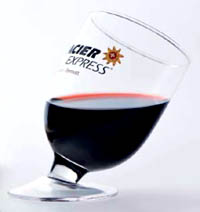 At their meetings of 16 Jun 2003 and 29 Aug 2003 respectively, the board of directors of the Matterhorn Gotthard Bahn and the Rhätische Bahn agreed to acquire new panorama cars for the Glacier Express. The new rolling stock included four completely new trains consisting of five panorama cars and one dining car each costing about 60 million Swiss franks. Having invited proposals internationally, the contract was awarded to Stadler Altenrhein AG. Some of the work was carried out by the two railways themselves. The introduction of the new rolling stock is scheduled to coincide with the coming into operation of the new timetable in May 2006. As well as being treated to new rolling stock passengers already benefit from a new operational concept and from 2006 will enjoy the delights of a new catering concept. The existing 14 panorama cars will be modernised in the course of the next few years and their interior design brought in line with the new carriages. From 2006 the Glacier Express for the first time ever will feature a 2nd class panorama car (48 seats), comfort in 1st class will be improved greatly, and the number of seats reduced from 48 to 36. In addition every Glacier Express train will have wheelchair places and a properly equipped disabled toilet in 1st class. Implementing the improvements to make this Alpine train more attractive and comfortable is quite a challenge for the purchaser, designers, and manufacturers of the new product. At their meetings of 16 Jun 2003 and 29 Aug 2003 respectively, the board of directors of the Matterhorn Gotthard Bahn and the Rhätische Bahn agreed to acquire new panorama cars for the Glacier Express. The new rolling stock included four completely new trains consisting of five panorama cars and one dining car each costing about 60 million Swiss franks. Having invited proposals internationally, the contract was awarded to Stadler Altenrhein AG. Some of the work was carried out by the two railways themselves. The introduction of the new rolling stock is scheduled to coincide with the coming into operation of the new timetable in May 2006. As well as being treated to new rolling stock passengers already benefit from a new operational concept and from 2006 will enjoy the delights of a new catering concept. The existing 14 panorama cars will be modernised in the course of the next few years and their interior design brought in line with the new carriages. From 2006 the Glacier Express for the first time ever will feature a 2nd class panorama car (48 seats), comfort in 1st class will be improved greatly, and the number of seats reduced from 48 to 36. In addition every Glacier Express train will have wheelchair places and a properly equipped disabled toilet in 1st class. Implementing the improvements to make this Alpine train more attractive and comfortable is quite a challenge for the purchaser, designers, and manufacturers of the new product.
Factors which had to be taken into account included requirements prescribed by the disability law, the optimum number of seats in economic terms, as well as lightness of structure to ensure the six loaded carriages do not exceed the maximum weight of 130 tonnes.
The east exit track in Brig which should be complete by 2007 is a further major project. Currently the Matterhorn Gotthard Bahn's station in Brig is a "terminal station" and requires a change of locomotives. The new line will head towards the SBB's Simplon Tunnel on the left bank of the Rhone and join the existing line in Bitsch. When this section of the line is opened the Glacier Express travel time is expected to be decreased by 20 minutes. Thanks to these improvements the showpiece train of the Matterhorn Gotthard Bahn and the Rhätische Bahn will continue to offer its passengers a comfortable and service-oriented trip through the Swiss Alps from the Engadine to the Matterhorn.
Helmut Biner - Matterhorn Gotthard Bahn Head of Communications
 | 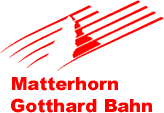 |
Back |

